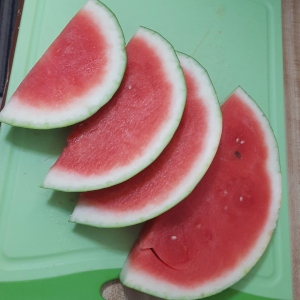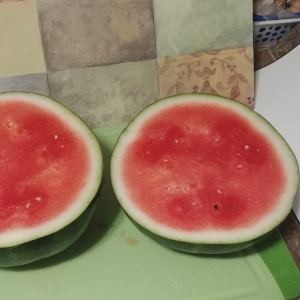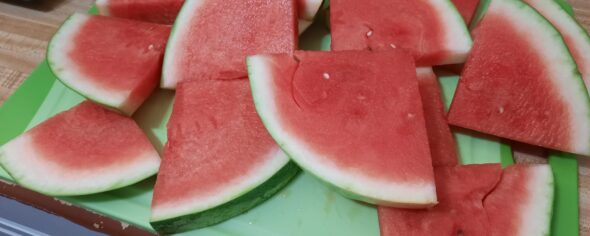Watermelon is nature’s refreshing gift and nothing says “summer” to me like biting into a crisp, juicy watermelon. It’s about quenching your thirst along with that summer heat. These days with globalization, I see watermelon in the markets year round, so this refreshing feeling of “summer” can be had pretty much year round now.
Is Watermelon Nutritious?
 This delightful fruit is not only a summertime favorite but a visit to the USDA website shows it’s also a nutritional powerhouse. Judge for yourself and look at the numbers.
This delightful fruit is not only a summertime favorite but a visit to the USDA website shows it’s also a nutritional powerhouse. Judge for yourself and look at the numbers.
A single cup of watermelon, weighing around 155 grams, offers a refreshing yet healthy snack. Now, you might be wondering if it’s okay to enjoy watermelon every day as a “snack”.
Well… err… so… The good news is that it’s low in calories and sugar, making it a guilt-free treat. However, for optimal health, it’s a good idea to vary your fruit intake since different fruits provide different nutrients. This shouldn’t be the only fruit you eat and then saying I ate my fruits today! It’s mostly water. The water is what makes it refreshing.
Watermelon isn’t just about quenching your thirst and supporting digestion. As you can see in the USDA link, watermelon boasts an impressive nutrient profile. A single cup provides vitamin C along with an array of vitamins and minerals, that includes potassium, vitamin A, and vitamin B6.
Not even mentioning Lycopene yet, the natural compound that gives watermelon its vibrant red color, is a powerful antioxidant with several potential health benefits. Lycopene has been linked to a reduced risk of cancer, heart disease, and is still being studied. Speaking of antioxidants, there’s some beta carotene in that watermelon as well I can see.
Hydration?
No doubt, watermelon is a hydrating fruit, with more than 92% water content. In the killer summer heat, watermelon can be a lifesaver, helping you stay refreshed while quenching your thirst. To make another point here, we’re not just talking about hydration from liquids; watermelon significantly contributes to your overall body hydration.
The water content can only spell good news for your skin, keeping it hydrated for a soft supple feel. Watermelon’s high water and fiber content promote healthy digestion as well. The water helps in the hydration while the fiber adds bulk to your stool and keeps things moving smoothly through your digestive system.
Additionally, the feeling of fullness you get from eating watermelon can aid in a person’s own weight management. Replacing your higher-calorie snacks with watermelon can potentially lead to a decrease in your body weight, body mass index, and in general overall.. your waist circumference… simply because your eating bulk without the bulk calories.
Don’t Discard the Rinds
After you’ve devoured the flesh, you are left with the watermelon rinds. The rinds are lower in sugar and higher in fiber than the flesh. This can help slow down sugar absorption and reduce blood sugar spikes.
Pickled Watermelon Rinds – Most people will let you tell you that the rinds can be pickled, and they’re right. Pickled watermelon rinds taste absolutely great. I will always peel the rinds first and the pickling liquid can be made with such a huge range of sweet and sour flavors. It is a welcome change to a normal cucumber pickle.
Watermelon Rind Slaw – Again, peel first. Grate or julienne the rinds to make a crunchy slaw. You can combine them with other vegetables like carrots and cabbage and dress it with your favorite coleslaw dressing.
Watermelon Rind Salsa –Always peel first. Make a watermelon rind salsa with onions, peppers, lime juice, and cilantro. It’s a zesty topping for tacos, fajitas, grilled meats or a dip for tortilla chips.
Watermelon Rind Bowl – Do not peel this one! Cut the ends off a full watermelon and dig the watermelon flesh out of the two “bowls” you just cut off.
These are just a few ideas but generally if I’m goin to be eating the rind, I’m peeling it. If the rind is going to be just for looks, like a bowl for punch or dip, leave the peel on.
Downsides here?
Now, you might be wondering about the potential downsides are of adding watermelon to your diet. While watermelon is generally safe and healthy, there are some exceptions and “healthy” can be a loaded term. As one example, those with diabetes should monitor their watermelon intake just like they should all fruits due to their natural sugars.
Moreover, watermelon is considered a high FODMAP fruit, which means it contains sugars that can be difficult for some people to digest. This can lead to bloating, constipation, or diarrhea in individuals with conditions like irritable bowel syndrome (IBS).
I’ll Summarize
Watermelon is a delightful, nutritious, and versatile fruit that can contribute to a healthy diet. It’s a refreshing choice for staying hydrated, promoting healthy digestion, supporting weight management, and delivering a burst of essential nutrients. So, whether you’re slicing it up for a summer picnic or blending it into a refreshing smoothie, I hope I’ve educated you a bit more on how to make watermelon a regular part of your diet.
Remember, moderation is key in maintaining a balanced diet. While watermelon is a healthy choice, it’s best enjoyed as part of a diverse selection of fruits and foods. So, go ahead and savor the taste of summer with this sweet and juicy gift from nature.


